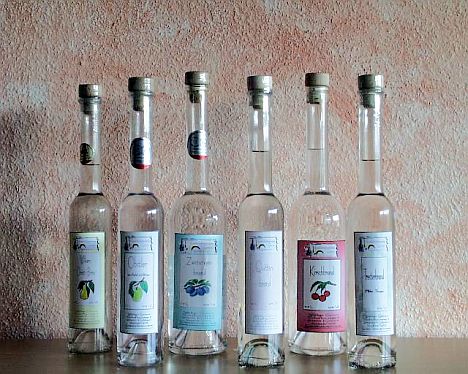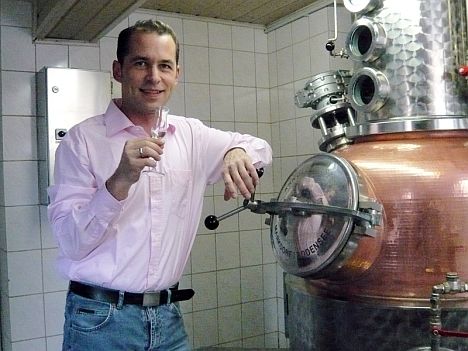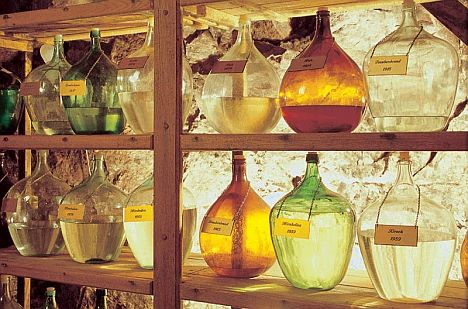The most important quality of a noble distiller is patience. "If you don't have time, you can't make good brandies," says Stephan Grimm. The 36-year-old noble distiller from Külsheim in northern Baden takes a deep breath of the intensely powerful aroma of his sloe noble brandy in the glass and emphasises: "The most important thing is the choice of fruit. It has to be really ripe, otherwise it won't work." His family owns around 260 fruit trees in the small half-timbered town, which lies on the edge of the idyllic Tauber valley between Wertheim and Tauberbischofsheim.
Fine wines from their own fruit: good spirit has a long tradition in Tauberfranken, which here belongs to Baden-Württemberg and yet is only about 50 minutes' drive west of Frankfurt. Ten noble fruit distilleries offer clear goods in Külsheim and the surrounding area alone. The entire south side of the Main via Freudenberg, Miltenberg, Amorbach, Großheubach to Stockstadt and Aschaffenburg is little-discovered distillery country - several dozen small businesses produce regional rustic to highly elegant distillates here.
 |
| The collection by Stephan Grimm |
Stephan Grimm is one of these traditional sideline distillers rooted in the region. Already in the fourth generation, the family is practising the old distilling craft, which he has carefully modernised. With the new distillation plant in the outbuilding of his neat family home, he produces 300 litres of alcohol per year, strictly monitored by customs. This is the quantity limit for "severance distillers", as the small businesses are called for tax purposes - and so typical of this region.
Drudgery and manual labour before distilling
Grimm is not a trained master distiller. He works as a buyer, is often on the road in Asia and India. He got the knowledge about spirit and brandy from his parents. "I distilled for the first time myself when I was 18," he recalls, "and I learned the most important subtleties from my mother." He continued his education in seminars at the University of Hohenheim and today focuses on class instead of mass - and takes his time: "The cool fermentation of the mash takes days, and distilling a single still with mash of the best quality takes six, seven hours." Then there are the preparations: "We cleaned 350 kilogrammes of quinces by hand, ground them and fermented them as mash to end up with just under 15 litres of brandy," he says. For his sloe brandy, he needed 40 kilograms of fruit to obtain one litre of distillate. The drudgery paid off: at the award ceremony of the Baden Small and Fruit Distillers 2006, he won a gold medal for both brandies. He has been taking part in the biennial competition since 1996 "to find out where I stand in the competition."
 |
| Stephan Grimm |
He stands in good stead: around a dozen awards decorate the salesroom in the basement of his detached house in the middle of the new development area. Here, during the day, his wife serves the neighbourhood customers who still prefer to choose the classic Williams Christ pear. He leaves the brandy and spirit in the bottle for two years until they reach the shelves in sizes between 0.1 and one litre - at prices between eight and 18 euros for a half-litre bottle. Two restaurants in Frankfurt and Bremen already list the Külsheim Kreszen on their menus.
The Steinton is the traditional flavour of the region
His plum, mirabelle plum and cherry brandies have a subtly sweet taste of bitter almonds. "That comes from the blue acid traces in the stones, some of which we also ferment," Grimm explains, "the stone clay is the traditional flavour of the region, it belongs here." Just like plum, mirabelle plum and apple - these are typical northern Baden brandies. The reason: "There are many ancient trees here with these varieties on which fully aromatic fruit ripens."
Highest quality - that is also the claim of a company whose name belongs to the classics of noble brandies: The Ziegler distillery, founded in 1865 as a brewery with distilling rights, is located in Freudenberg am Main, just behind Miltenberg in the northernmost tip of Baden. With its famous "Wildkirsche Nr.1", Ziegler has set a standard in luxury gastronomy. But Baden tradition no longer plays a role here: the company belonged to the Leibbrand grocer's group for a long time until Alain Langlois took it over. The Burgundy-born wine expert began to put the fluctuating quality of the business on a new footing. "In 1998, we installed a gentle technique for de-stemming the fruit, a computer-controlled mash fermentation system with temperature control and a distillation system with double distillation," he recalls, "otherwise we would never have managed the new start." The sparkling stainless steel tanks for fermenting the mash now sit enthroned above the inconspicuous distillery building between the banks of the Main and the edge of the forest. Above, a stream bubbles down the steep mountain slope. The distillers use its soft spring water to reduce the spirits to the right alcohol strength.
 |
| The ice cellar of the Ziegler distillery% This is where the brandies mature |
Grape marc brandy from 1918 in the old ice cellar
In the old ice cellar, only 50 metres from the main building, dozens of old vintages and valuable rarities are stored in plain glass balloons - such as a marc brandy from 1918. But times are changing: "What people liked 30 years ago, nobody wants today," explains Langlois. He therefore developed wood barrel-aged brandies made from plum, apple and Riesling pomace that match the aroma of the cigar trend. Under the brand name "Kvlt", his wife Barbara Wolf-Sykes also designed three fruit brandies and a raspberry brandy, which also look good in trendy bars.
Ziegler sources the fruit mainly from contract farmers, for example from the Valais, Burgenland, Lake Balaton and Lorraine. "We want the best fruit at the best stage of ripeness," Langlois describes his quality standards. "The market for noble brandies is not growing, it's pure cut-throat competition," he says, describing the fierce competition between the spirits. He therefore looks to Austria, because the distillers there "set standards throughout Europe that we want to measure ourselves against". That is why the region is of little importance to Langlois: "Most customers don't even know that we are based here on the Main. They assume we are in the Black Forest," he laughs.
Finest Brandy from Wild Orange
 |
| Hans Adrian |
Just a few kilometres further down the Main, the coordinates change again: In the Bavarian town of Großheubach am Main, near the Hessian border, a distiller has devoted himself entirely to the Franconian distilling tradition. Hans Adrian distils "Franconia's most unusual schnapps", as the local newspaper headlined it, in his business, which was founded as a coppersmith's and distillery in Oberursel am Taunus back in 1811. The 58-year-old noble distiller makes a finely aromatic brandy from kumquats, which he got to know a few years ago during a holiday in Israel. "It was clear to me that I could make something out of them," he says. So he left his clothes and utensils behind and returned with a suitcase and a backpack full of the fragrant little oranges. Adrian looked for and found an exporter who could deliver the fruit to Frankfurt airport within 24 hours of picking - production could begin, and Adrian received awards by the dozen for his "Wild Orange", as he imaginatively calls his top product - "Nobody knows kumquats here," he decided. His second speciality, on the other hand, comes from the neighbourhood: Hans Adrian distils a very fine brandy full of fruit from the Reneklode. An acquaintance told him that he wanted to cut down his reneklode trees because they were not yielding enough. "I immediately persuaded him to leave the trees and sell me the annual production," he recalls.
The company, which produces around 10,000 bottles a year, belongs to the Franconian "Rosenhut" association, which named itself after the bag-like attachment above the medieval still. The ten or so members between the Lower Main and Franconian Switzerland are committed to working to high quality standards. Adrian bottles noble vintage brandies under the "rose hat" - but only if the fruit quality is right.
Enjoy not too warm and not too cold
His greatest success: star chef Jörg Müller stocks Adrian's brandies in an exclusive bottling in his noble hotel restaurant in Westerland on the island of Sylt. The Franconian noble distiller recommends his customers to enjoy the high-proof spirits at a temperature of about 16 to a maximum of 20 degrees. "If they are too warm, they develop a pointed sweetness and taste alcoholic," he explains, "and if they are too cold, the full fruit aroma cannot develop sufficiently." All types of stone fruit brandies can be stored excellently. Only one thing is important: "The bottles should be protected from light, preferably in a box. This way, the distillates will keep their beautiful aroma for years, "only Williams Christ has to be drunk within one or two years, because the intense smell will fade away," Adrian warns. Opened bottles should also not be left for months or years - the spirit simply disappears into nothingness once it is let out of the bottle. Although it takes so much time and effort to get it in there.